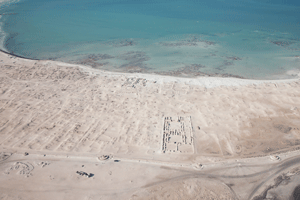Archaeologists excavating
on the shores of the Persian Gulf
search for what may prove to
be the source of the world's
longest-lived economy

The once-thriving 18th- and 19th-century
pearling center of Zubarah sits on the
northeast coast of Qatar. At its peak around
1800, the city was surrounded by a 1.5-mile-long
wall with 21 still-visible round towers and
had a population in excess of 5,000.
(Courtesy University of Copenhagen)
For at least 7,000 years, people have settled
along the shores of the Persian Gulf, in what
one scholar calls "one of the most inhospitable
regions on the planet." Despite its lack of natural
resources, such as water or fertile soil, what the
Gulf region did have was the world's most reliable
source of fine pearls, until they began to be grown artificially
a century ago. The long history of pearls and pearling in
the Persian Gulf was, as a result, largely forgotten due to the
collapse of the natural pearl industry in the early 1900s. Soon,
the region came to be known only for exporting oil, despite
the fact that some of the cities lining the Gulf's coast actually
owe their early origins to pearls.
The luminescent gems have been prized as a symbol of
luxury since antiquity. The ever-increasing demand for the tiny
spheres not only attracted people to the Gulf's Arabian shores,
but also provided the raw material for an economy that may
have been one of the most enduring in the world. Nearly all
that was known about the ancient pearling industry came from
scattered mentions in texts that date only as far back as the
fourth century B.C. However, archaeologists working at sites
from Kuwait to Oman are now discovering evidence of ancient
pearls, pearling, and the pearl trade. Because of this, they are
beginning to understand the role the gem played in the region
at Neolithic villages, Bronze Age centers, and wealthy cities of
the eighteenth century. Says Robert Carter, an archaeologist at
the University College London's new campus in Doha, Qatar,
"The societies of the Gulf were shaped by the pearl oyster and
trade from the earliest days."

To read more, find ARCHAEOLOGY in your local newsstand or bookstore, or click here to buy a copy of the issue online. And if you'd like to receive ARCHAEOLOGY in your mailbox, click here to subscribe.
Andrew Lawler is a contributing editor at ARCHAEOLOGY.

